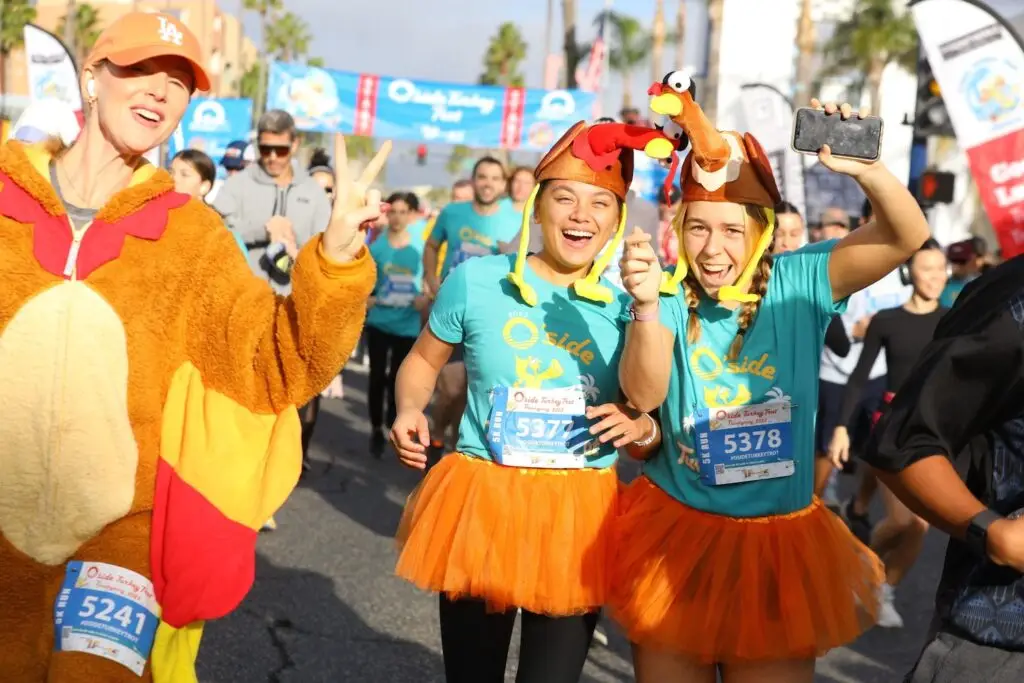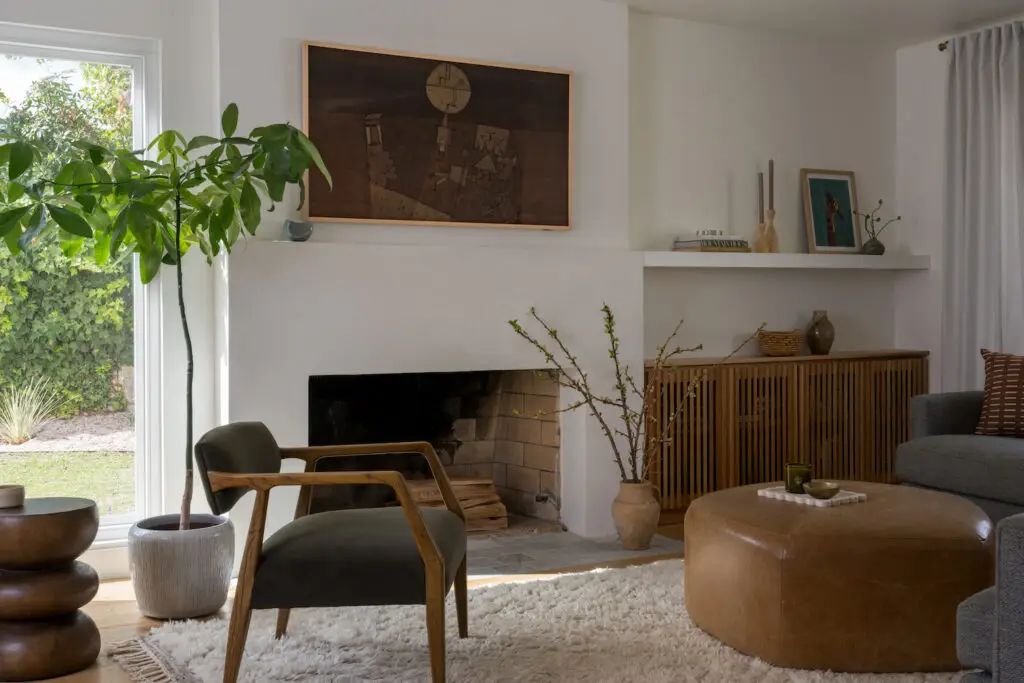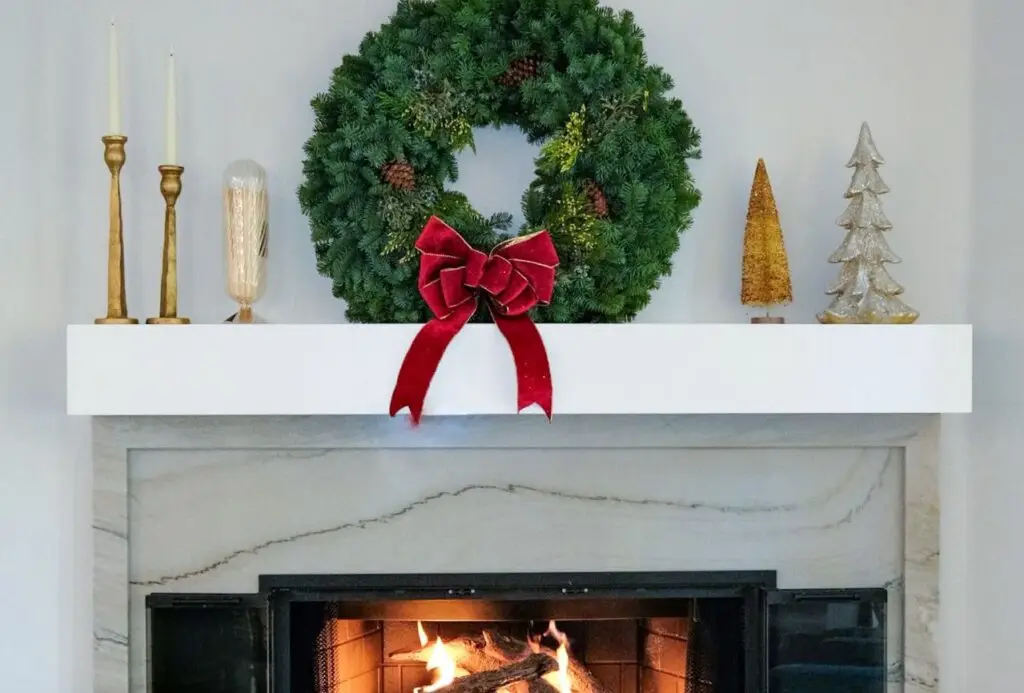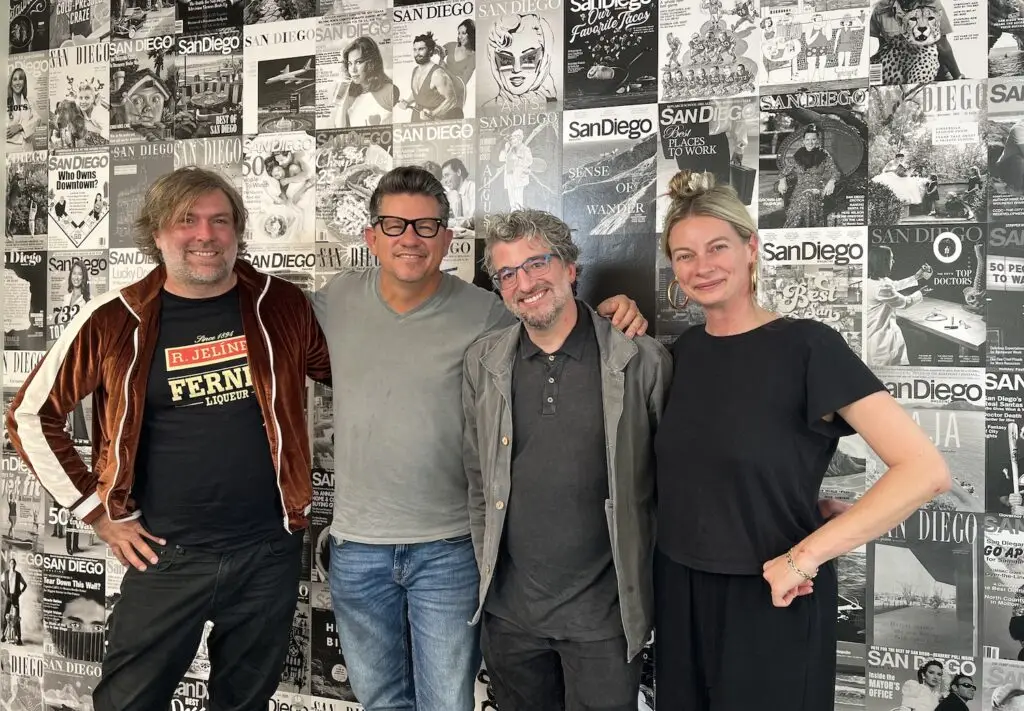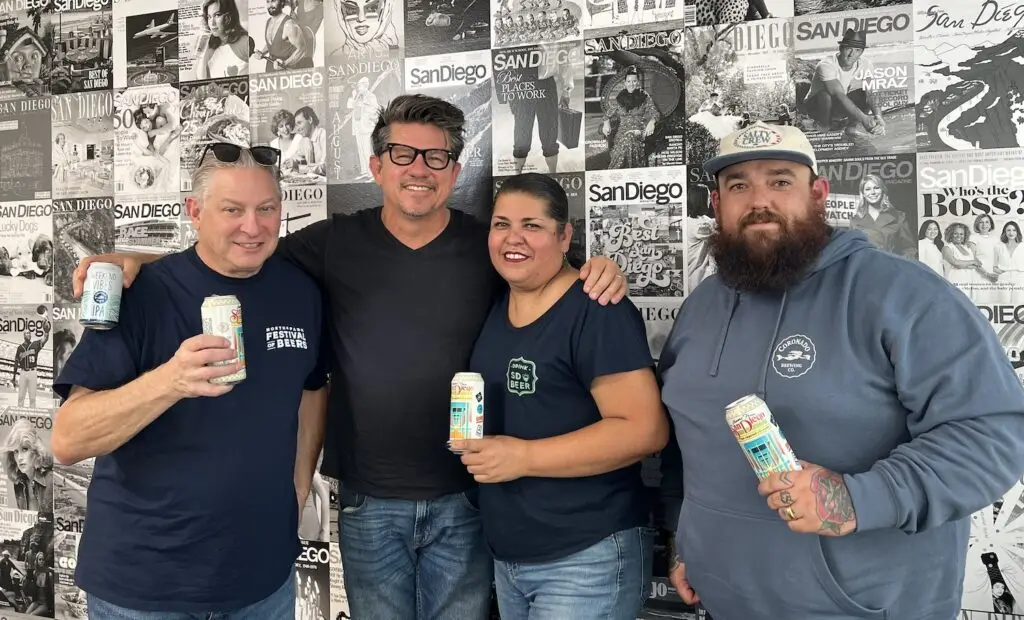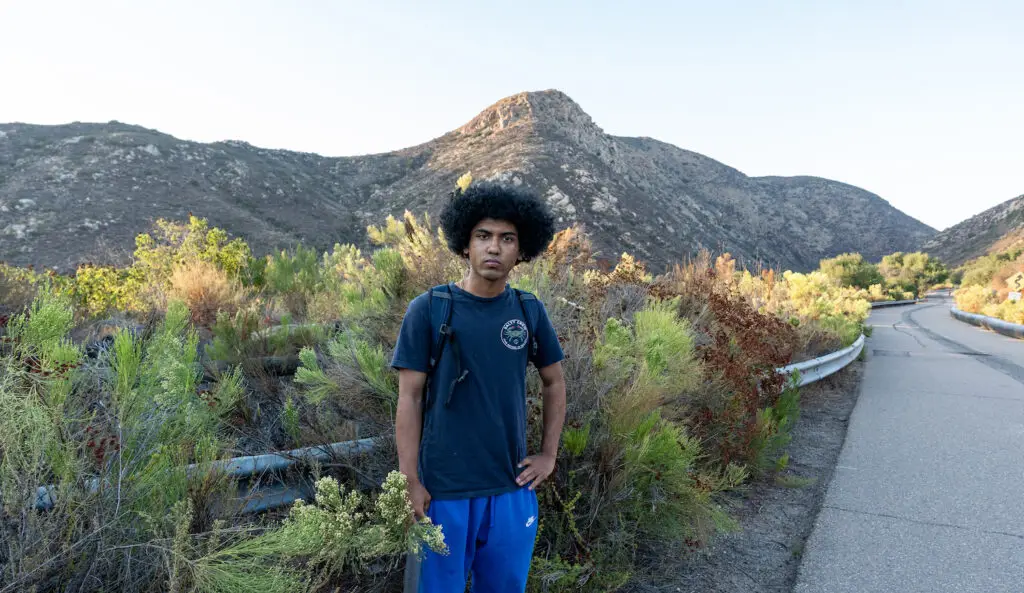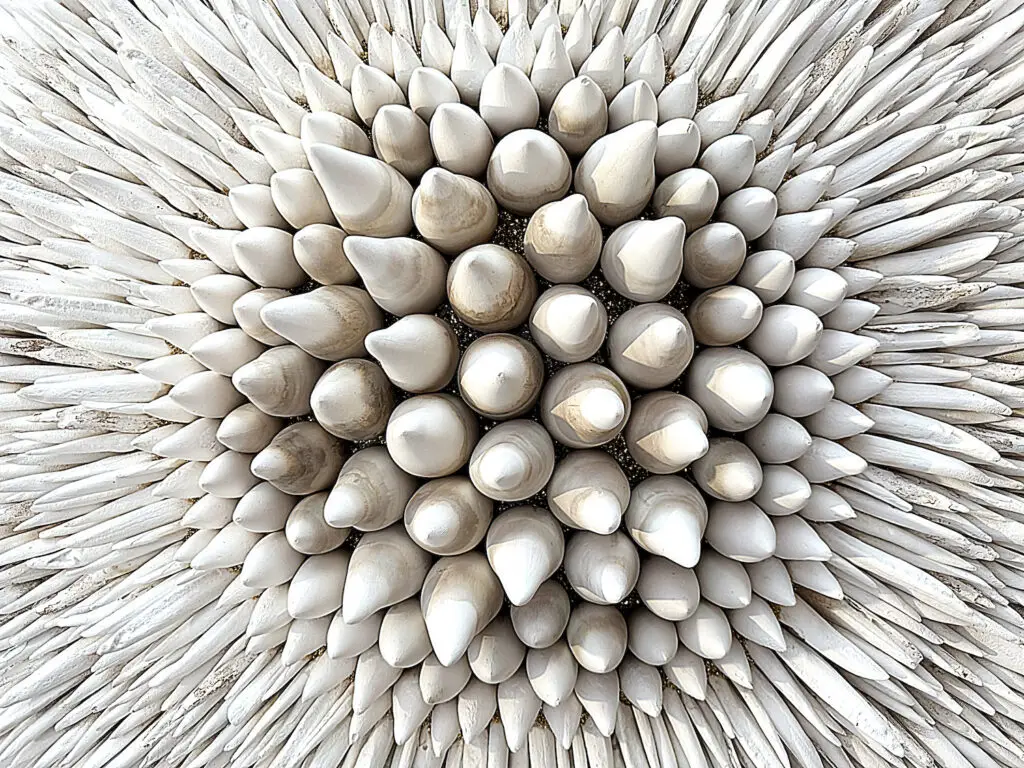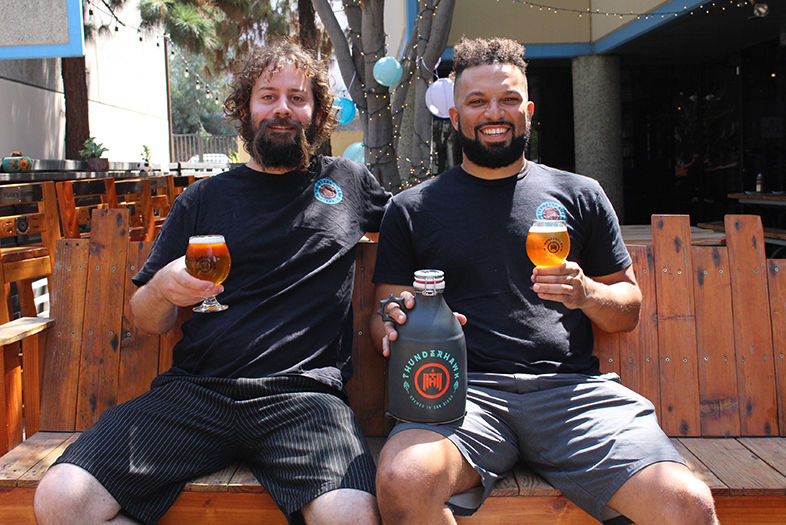With so many breweries competing for attention in San Diego, it’s especially challenging to be super small. The guys at Thunderhawk Alements know those challenges better than most—their 1-barrel system produces just enough beer to satisfy the thirst of their Miramar tasting room customers and leaves very little left over for distribution elsewhere. That’s why—despite the fact that Thunderhawk makes excellent beer—you may not know of them (yet).
With their 1-year anniversary fast approaching, I sat down with owners/brewers Jonathan Barbarin and Bill Lindsay to talk about what their first year has brought them and what it’s like brewing in the shadows of San Diego goliaths like AleSmith and Ballast Point. As we chatted, I sipped on a delicious and perfectly balanced pint of Liberty’s Teeth ESB that had been wet hopped with locally grown Santiam hops (in fact, Thunderhawk did a series of Liberty Teeth brews, each wet hopped with a variety of San Diego hops).
Liberty Teeth is just one example of the creative and well-conceived recipes they regularly brew at Thunderhawk. From my first visit nearly a year ago, I was impressed by the range of styles that emanated from such a tiny system. I was also intrigued by the unique approach they take to combining flavors in their recipes (Torreyana, for example, is one of their opening day beers; it’s a saison brewed with orange blossom honey and ginger and then fermented in American Oak).
You guys have made it through your first year in business, in one of the most competitive brewery environments in the country. Are there any things in particular that you hadn’t anticipated—either good or bad—about running a San Diego brewery?
Jonathan: On the good side, it was a lot easier than I thought just to get to know people in the brewing community and to get help from people who have no stake in helping us. It was just generosity. It’s something that’s talked about a lot in San Diego, but I guess unless you’re in the scene you might not experience it.
You guys hadn’t been working at other breweries before you started Thunderhawk, right?
Bill: We did a little sales at Firestone, but neither one of us had done production.
Jonathan: We had no San Diego brewery experience, I guess you could say. We had a couple of friends who were in the industry, but for us it was all about getting in with only knowing maybe one or two people. So, just the reception has been pretty awesome and it’s been super encouraging. I think maybe people enjoyed the fact that we were just two homebrewers—you know, just two guys pursuing their dream—and there may be something a little romantic about that. But definitely, for us, I feel like a lot of our success has come from the positive feedback we’ve gotten from the brewing community and the public too. You know, one of the coolest things is just having regulars—people that we didn’t know before we opened—and that’s pretty reassuring. It’s not like your friend, or your mom, or your dad sitting at the bar every Friday night; it’s people who just really like to be here and really like what we make.
Bill: Our friends, family, and other people we knew definitely got us into this and pushed us to open, but—like Jonathan said—it was finding people we don’t know and seeing them come back constantly; that’s awesome.
You guys had homebrewed together for a long time before opening up. What was that dynamic like?
Bill: We both like eclectic lineups.
Jonathan: I think that’s a great way to put it. We both like a lot of different things and we’re both willing to always try new beer and to experiment making new beer. In the past few months we’ve gotten really comfortable with the brewhouse and we’ve done a few collaborations, like the one with Newtopia Cyder and the ones with Setting Sun Sake and Home Brewing. We’ve kind of gotten confident enough to step out of our routine—doing our core beers—and we’ve gotten ready to do something totally different, which has been a really good transition for us. It’s also much needed because, in this market, it seems like the consumer is always chasing the “next thing,” which makes it tough to be in San Diego. I think there are some people here who are doing it really well; they’re creating new beers constantly and they’re high quality, which seems to be what consumers are demanding.
It’s a challenge to stay relevant in this market.
Bill: Yeah. The most-asked question in the tasting room is, “What do you have that’s new?” Every day, the question is, “What’s new?”
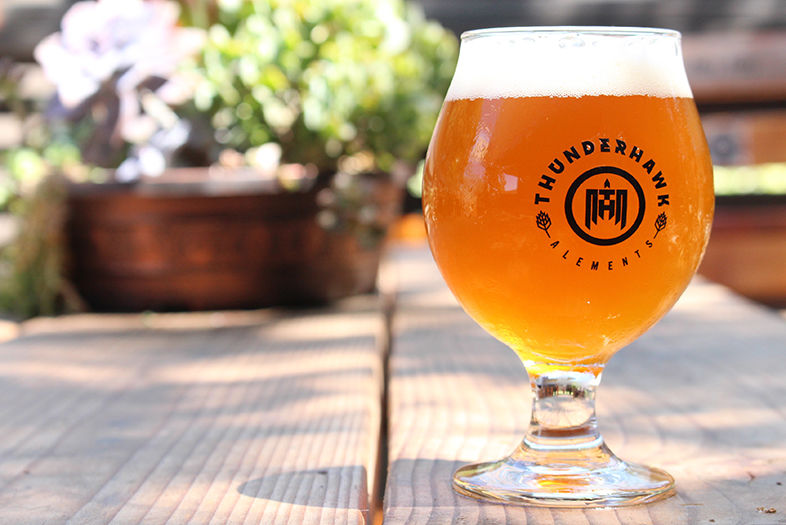
Have a Beer with Thunderhawk’s Bill Lindsay and Jonathan Barbarin
New Thunder is a wheat ale and apple juice collaboration done with Newtopia Cyder. | Photo: Nate Glassman-Hughes
Do you feel your customer base is pretty open to trying new stuff and experimenting?
Jonathan: I think so. It seems like most of the people that come in, especially our regulars, they’re always willing to try whatever’s new on the board. They’ll try the new beer, think it’s interesting, and then go back to their favorites, like the Torreyana Saison or the Punt Gun IPA.
Your Electric Youth Coffee Pale Ale and your Dunkelweizen, both of which you’ve had on from the day you opened, are not “mainstream” beers, but they seem to have survived the test of time.
Jonathan: We get a really good response with the Dunkel from the craft beer community more than the non-brewers and the non-publicans. I think they just have a greater appreciation for the old school styles that people around here are not making as much. It’s not a great seller, but it’s something we love to have on the board and we both enjoy drinking. And it’s more exciting than a brown ale or an amber.
Bill: A lot of people don’t know what the Dunkel is, but—like Jon said—when it’s people in the industry, they definitely want to try it.
Do you think you’ve turned a bunch of people on to the beauty of Dunkelweizen?
Bill: A lot of people are afraid of a darker beer. We have to tell them that it’s not a stout and it’s not heavy. It has darker malts so it looks dark, but it does not drink like a stout. It’s not super heavy. When they try it, they’re like, “Wow!” The other thing that happens is, if we give someone the Dunkelweizen and our coffee pale ale at the same time, they always ask which is which because they are assuming the coffee beer is going to be dark. That’s because every time people hear the word “coffee,” they think stout.
Jonathan: Yeah, people order the coffee pale ale, and you pour them a pint, and they say, “Wait. I thought it was going to be dark.” They don’t pay attention to the fact that it’s a pale ale, first and foremost. We’ve gotten tons of great feedback on both Torreyana and Electric Youth, and—behind Punt Gun IPA, which is our best seller—Electric Youth is right there at number two and Torreyana is number three. So that’s cool. I think we kind of went out on a limb and took a little bit of a risk trying to be different and showcase those beers, but it’s paid off. A lot of people know us especially for Electric Youth.
Do you have draft accounts in town?
Jonathan: We have one. We’re really not pursuing that right now. With a 1-barrel brewhouse it’s hard to keep our menu full. We’re selling everything here in the tasting room. We do want to do a little bit of distribution, just to have a presence in different areas and brewpubs, especially where people may not be getting up to Miramar consistently. We’d like to get their attention and maybe, when they’re on that party bus, they’ll think to stop at Thunderhawk.
Do you have plans to expand the brewhouse at any point?
Jonathan: We do, but we can’t do it here, unfortunately. We do eventually want to find a new space, probably in the Miramar area and just build a bigger brewhouse. That will lead to more outside accounts and hopefully also canning beer, which has always been a goal for us. Our new crowler machine is step one—right now it’s one can at a time!
What advice do you have for all the homebrewers out there who dream of turning pro?
Bill: Making the step up, right at the beginning, is huge. One brew day number one, It took us 20 hours to do 2 barrels! Now we can do 4 barrels a day, taking about 16.5 hours all together. So it’s the learning curve. We scaled up from 10 gallons to 1 barrel, which doesn’t sound like much, but the grain efficiencies are way different and so are the hop efficiencies. Our first beer was supposed to be about a 5% English Pale Ale and it turned out to be a 7.6%. I knew the calculations weren’t going to be a linear equation, so we just had to guess and take it from there.
Jonathan: The other big thing is the time demand. Everything just takes longer than you expect—whether it’s brew processes or dealing with different vendors to get T-shirts made—it’s just a lot more planning than you would think going into it. And then there’s all the regulations. It just feels like you’re never not doing paperwork. So, to the guys out there just starting, you should know that is just a huge obstacle.
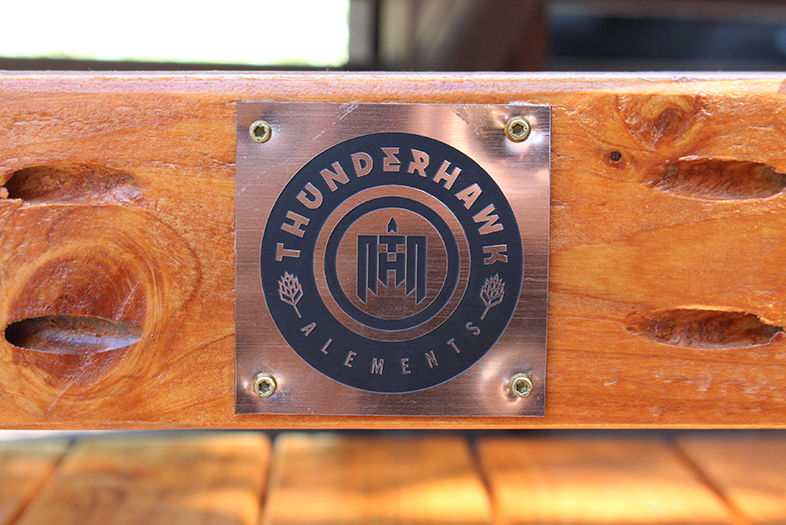
Have a Beer with Thunderhawk’s Bill Lindsay and Jonathan Barbarin
The Thunderhawk logo evokes a Native American connection. | Photo: Nate Glassman-Hughes
What would you say are the things you’re most proud of from the past twelve months?
Jonathan: A few months after opening, we were mentioned in an article in The New York Times about “Beer on a Budget,” and in paragraph one, they were talking about our coffee pale ale. That was something we didn’t even know was coming; I guess this writer had come through and tried some beer and never said anything to us and took off, but that was cool. Just having that reach that far across the country in an international publication was a really cool thing for us.
And didn’t you have some beers win in the San Diego Magazine blind tasting we did for the last Beer Issue?
Jonathan: Yeah! Torreyana took second place in the Belgian category and Over There Dunkelweizen took third place in the malty category. That was huge too. I mean, based on that—and being listed in the Top 10 Best New Breweries—those three articles have given us more flow than anything out there.
You guys have a little Miralani brewing enclave going here. Across the street you’ve got three breweries, two wineries, and a sake brewery; and next door here you’ve got a meadery/cidery opening.
Jonathan: Yeah. We’re in the early stages of forming this organization called the Miralani Makers District. We’re in the process of formalizing it; we’re getting logos made and building out a marketing network for it.
Bill: We want it to be a destination you can come to and then walk to as many places as you like.
Jonathan: Everybody knows each other over here, and we’re all friends for the most part. And we’re all constantly drinking at each other’s places and borrowing equipment—all the things neighbors do! So we figured why not get together and pool our resources and pool our networks and promote this whole place.
A lot of people are curious: What’s the official origin story of the name?
Jonathan: The name spawned from a homebrew session back in November 2010 when we were brewing in OB on Bacon and Narragansett Street. Bill, a couple of friends, and myself were all hanging out around the kettle as a plane was flying overhead. That’s when our friend yelled out, “ALL HAIL THE MIGHTY THUNDERHAWK!” We all had a good laugh and I said, “That sounds like a badass name for a beer.” We all laughed a little more and went on to finish that brew session and go home. Not too long after, we shared that story with some friends at our annual Ugly Sweater Christmas Party and from then on our friends started calling our brews “Thunderhawk.” Four years later, Bill and I decided to start a brewery and we officially chose that as our name. We loved the strength it exudes, and the fact that it wasn’t already trademarked made it an easy choice. We opted to go for a Western/Native American theme as it seemed fitting; with my father’s Creole/Native American Heritage (I still have family in New Orleans who participate in Mardi Gras as Mardi Gras Indians) and a lifelong appreciation for the Native people of the U.S., it seemed like a natural fit. Interesting enough, even though we’ve only been open for a year, there are a lot of people in San Diego who have known us as Thunderhawk for years.
So how are you guys celebrating the 1-year anniversary?
Jonathan: Well, officially we were one year old on September 17th, but we’re going to be throwing a big party here on Saturday, September 30th. We’ll have food and music—a band called Thunderfunk, which is mostly members of a local band called The Routine; they’ll be performing from 7 p.m. to 9 p.m. And we’ll have some new beers—it’s just going to be a big celebration. Saturday the 30th from noon to 10 p.m.
What are the special beers you’ll be releasing for the occasion?
Jonathan: We should have a special collaboration wet-hopped saison we did with Home Brewing Company; a sake-inspired beer that we did with Setting Sun Sake; another wet-hopped English Ale; and we’ll have most of our core lineup back as well. Should be an exciting day!
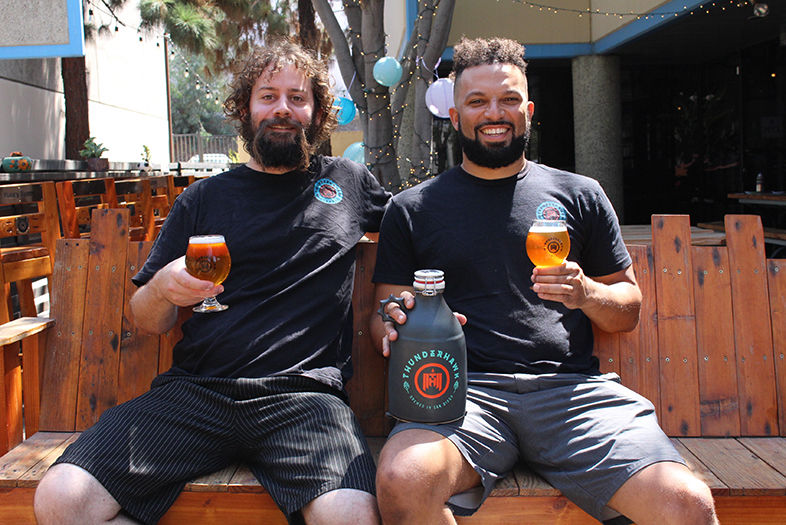
Have a Beer with Thunderhawk’s Bill Lindsay and Jonathan Barbarin
PARTNER CONTENT
Thunderhawk co-founders and brewers Bill Lindsay (left) and Jonathan Barbarin | Photo: Nate Glassman-Hughes



